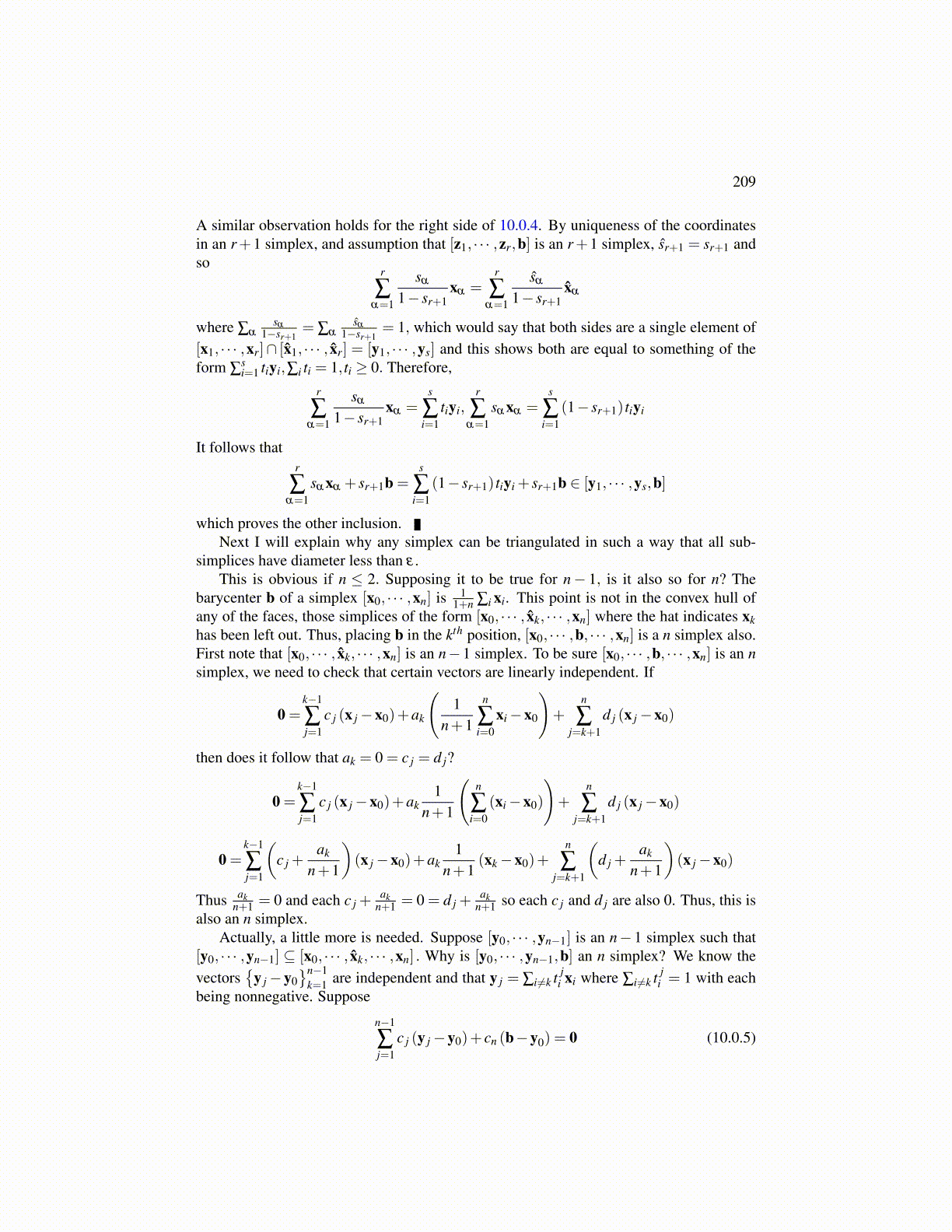
209
A similar observation holds for the right side of 10.0.4. By uniqueness of the coordinatesin an r+1 simplex, and assumption that [z1, · · · ,zr,b] is an r+1 simplex, ŝr+1 = sr+1 andso
r
∑α=1
sα
1− sr+1xα =
r
∑α=1
ŝα
1− sr+1x̂α
where ∑αsα
1−sr+1= ∑α
ŝα
1−sr+1= 1, which would say that both sides are a single element of
[x1, · · · ,xr]∩ [x̂1, · · · , x̂r] = [y1, · · · ,ys] and this shows both are equal to something of theform ∑
si=1 tiyi,∑i ti = 1, ti ≥ 0. Therefore,
r
∑α=1
sα
1− sr+1xα =
s
∑i=1
tiyi,r
∑α=1
sα xα =s
∑i=1
(1− sr+1) tiyi
It follows thatr
∑α=1
sα xα + sr+1b =s
∑i=1
(1− sr+1) tiyi + sr+1b ∈ [y1, · · · ,ys,b]
which proves the other inclusion.Next I will explain why any simplex can be triangulated in such a way that all sub-
simplices have diameter less than ε .This is obvious if n ≤ 2. Supposing it to be true for n− 1, is it also so for n? The
barycenter b of a simplex [x0, · · · ,xn] is 11+n ∑i xi. This point is not in the convex hull of
any of the faces, those simplices of the form [x0, · · · , x̂k, · · · ,xn] where the hat indicates xkhas been left out. Thus, placing b in the kth position, [x0, · · · ,b, · · · ,xn] is a n simplex also.First note that [x0, · · · , x̂k, · · · ,xn] is an n−1 simplex. To be sure [x0, · · · ,b, · · · ,xn] is an nsimplex, we need to check that certain vectors are linearly independent. If
0 =k−1
∑j=1
c j (x j−x0)+ak
(1
n+1
n
∑i=0
xi−x0
)+
n
∑j=k+1
d j (x j−x0)
then does it follow that ak = 0 = c j = d j?
0 =k−1
∑j=1
c j (x j−x0)+ak1
n+1
(n
∑i=0
(xi−x0)
)+
n
∑j=k+1
d j (x j−x0)
0 =k−1
∑j=1
(c j +
ak
n+1
)(x j−x0)+ak
1n+1
(xk−x0)+n
∑j=k+1
(d j +
ak
n+1
)(x j−x0)
Thus akn+1 = 0 and each c j +
akn+1 = 0 = d j +
akn+1 so each c j and d j are also 0. Thus, this is
also an n simplex.Actually, a little more is needed. Suppose [y0, · · · ,yn−1] is an n− 1 simplex such that
[y0, · · · ,yn−1] ⊆ [x0, · · · , x̂k, · · · ,xn] . Why is [y0, · · · ,yn−1,b] an n simplex? We know thevectors
{y j−y0
}n−1k=1 are independent and that y j = ∑i ̸=k t j
i xi where ∑i̸=k t ji = 1 with each
being nonnegative. Suppose
n−1
∑j=1
c j (y j−y0)+ cn (b−y0) = 0 (10.0.5)